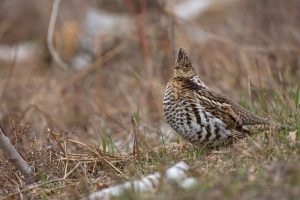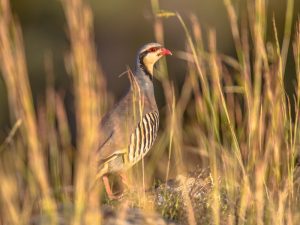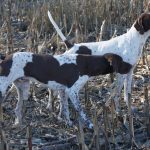2019 Upland Gamebird Hunting Forecast Updates
By Dave Smith
This update to our 2019 Upland Gamebird Hunting Forecast incorporates the results of late summer upland bird population surveys. This data measures recruitment of birds into the fall population, providing a more finely tuned forecast than was possible at press time for the magazine in mid-July.
Our annual PDJ Upland Gamebird Hunting Forecast is a detailed look at upland game populations and hunting opportunities for the upcoming season across about 40 states, coast-to-coast, border to border. The forecast is typically a mixed bag of ups and downs triggered by wildly different weather patterns from last winter through this summer across the nation. This year was different.
In 2019, a consistent theme emerged from across most of the Great Plains, Upper Midwest, and West: Following a cold snap in late winter, a wet cycle settled in. It rained, and rained, and rained some more. The countryside turned green and stayed green, rivers flooded out of their banks, upland vegetation grew lush and tall, and the moisture produced an abundance of insects to feed the broods of pheasants, quail, ruffed grouse, prairie grouse, chukars, and Huns. However, the late snow and/or extraordinary precipitation was likely too much for some species in some places, causing winter mortality, nest abandonment, or loss of early broods.
The upland gamebird experts were in a mid-summer quandary: Would the excellent summer habitat conditions conducive to excellent brood survival outweigh the adverse impacts of perhaps too much moisture during the nesting season? The best way to sort that out is via summer roadside or brood surveys that measure this year’s recruitment, unlike spring surveys that largely assess over-winter survival.
So, based on the survey data that has been analyzed to date, here’s some additional insight from those state fish and wildlife agencies to refine our forecast. And, as a new twist to this online update, we also gathered some qualitative intel from ruffed grouse experts in several states. Collectively, this update paints a picture of an exciting upland gamebird hunting season!
PHEASANTS
South Dakota’s roadside surveys revealed a 17 percent decline from last year. This year’s pheasants per mile index of 2.04 is 43 percent below the 10-year average (3.58). The highest counts were in the Chamberlain (4.85 pheasants per mile), Pierre (2.90), Mitchell (2.72), and Huron (2.55) areas, all of which decreased from last year. The state was pounded with several blizzards in March and April, then received the fifth highest May-July precipitation on record, and the highest since 1993. Adult hens and total broods both declined by 21 percent from last year. However, here’s a nugget of a different story in the numbers: The statewide average brood size for 2019 (6.24) is higher than the 10-year average (5.90). Further, Travis Runia of South Dakota Game Fish & Parks reports that the detectability of birds on the roadside surveys was likely negatively influenced by flooded ditches and 3.8 million acres of cropland that went unplanted this year. Think about those facts and read between the lines before dismissing a South Dakota pheasant venture this fall!
It’s shaping up to be a very good year in North Dakota. Thanks to a mild winter and great moisture all spring and summer, the roadside surveys detected a 10 percent increase for pheasants statewide, with total broods observed up by 17 percent. Pheasant densities were greatest in the Southeast region (51 pheasants per 100 miles surveyed), followed by the Northwest (41) and Southwest (39). The Northwest and Southeast should offer very good hunting as pheasant numbers were up 49 percent and 32 percent, respectively. In the state’s historically best pheasant country of the Southwest, total pheasants declined by 7 percent and broods were up by 2 percent from last year.
In Kansas, the extensive spring rainfall negatively impacted nesting, but the brood habitat conditions were excellent, resulting in an overall net gain in western Kansas. The summer brood surveys revealed increasing populations in the Northern High Plains (Northwest) region and stable to slightly better numbers than last year in the Southern High Plains (Southwest). Populations decreased in the South-Central Prairies and Smoky Hills.
Coming off the best pheasant harvest in a decade, Iowa experienced a snowy winter followed by a wet and cold spring – the recipe for declining pheasant populations, according to Iowa DNR’s pheasant-weather model. This summer’s roadside surveys confirmed the model’s prediction. Pheasant numbers declined by 17 percent from last year, but the 2019 statewide average of 17.4 pheasants per survey route is still 21 percent higher than the 10-year average. Populations should be relatively stable in all regions except the South-Central and Southeast regions that were hit with sub-zero temps and ice in January and February, then heavy rainfall in May.
In Minnesota, the 2019 range-wide pheasant index (37.4 birds/100 mi) decreased by 17 percent from 2018. According to Minnesota DNR, the overall decline is mostly attributable to cold and wet conditions during the nesting season. The roadside surveys revealed a 32 percent decline in the core pheasant range of southwest Minnesota, but the counts were up by 24 percent and 13 percent, respectively, in the South Central and East Central regions. The West Central region had the highest pheasant densities (48.8 birds/ 100 mi).
Nebraska’s pheasant population declined by 14 percent statewide from last year and is 19 percent below the five-year average. The birds came through the winter in good shape, despite the “bomb-cyclone” storms, but May was cold and wet, which negatively impacted nesting. Biologists reported seeing small broods in late summer, a function of re-nesting, but brood habitat conditions were excellent so the birds hatched late will likely do well. Populations declined in the two regions with the highest pheasant abundance – the Southwest (-13 percent) and the Sandhills (-50 percent) – but increased in the Central region (+83 percent).
RUFFED GROUSE
 The most straightforward ruffed grouse destination for this fall is Wisconsin! According to Alaina Gerrits, Wisconsin DNR, it looks like a stellar year to hunt ruffs: “With our drumming survey results up 41 percent statewide this year and expecting to be at the peak of the population cycle either this year or next, we have high expectations for hunting season this fall! Brood conditions were mostly favorable this spring and summer, with temperatures at or above normal and statewide precipitation at average or slightly above. There were likely localized rain events in portions of the state that could have hindered brooding, but we believe on the statewide level conditions were favorable.”
The most straightforward ruffed grouse destination for this fall is Wisconsin! According to Alaina Gerrits, Wisconsin DNR, it looks like a stellar year to hunt ruffs: “With our drumming survey results up 41 percent statewide this year and expecting to be at the peak of the population cycle either this year or next, we have high expectations for hunting season this fall! Brood conditions were mostly favorable this spring and summer, with temperatures at or above normal and statewide precipitation at average or slightly above. There were likely localized rain events in portions of the state that could have hindered brooding, but we believe on the statewide level conditions were favorable.”
It’s a similar story in Michigan, according to Al Stewart, Michigan DNR: “We had good brood-rearing conditions this summer and folks are finding a few more grouse than last year. It’s a little spotty, so you have to be in good habitat. It’s not like we are at the peak of the cycle when you can just go out anywhere in the woods and find grouse, but there are good numbers of birds in some places. We’re seeing some really young birds which were probably from re-nesting attempts after the heavy rains in May, so that’s a good sign for the future. And, as a bonus, the woodcock numbers look really good.”
Minnesota’s 2019 ruffed grouse brood survey report hasn’t been finalized yet, so the department wasn’t ready to make any updated projections, said Charlotte Roy, Minnesota DNR.
Maine looks like another good choice for traveling ruffed grouse wingshooters. The hunting was reasonably good last season and the biologists are cautiously optimistic this year. Kelsey Sullivan, Maine Department of Inland Fisheries & Wildlife, says it looks promising: “We’re seeing a good number of broods out there. They’re not as big as a good year in terms of number of chicks, but there are quite a few overall broods around. The leaves are changing but likely will not be dropping until mid-October.”
In New York, the projections are mixed. Michael Schiavone, New York Department of Environmental Conservation, says that the record-low number of grouse observed on the 2019 drumming survey is alarming, but weather may have played a role: “The cold, wet weather in May could have limited the frequency with which birds were drumming and contributed to the large drop in the drumming rate between years. At the statewide scale, the drumming rate from the spring survey and the flush rate from the Grouse and Woodcock Hunting Log conducted during the fall are correlated (i.e., when we observe an annual change in the drumming rate, we see a similar change in the flush rate). Based on this, we anticipate that the flush rate during the upcoming 2019-20 hunting season will be substantially lower than last fall (0.68 grouse flushed/hour in 2018-19) and below the long-term average flush rate (about 1 bird/hour).” However, Andy Weik, Ruffed Grouse Society, says he’s received reports from early-season hunters in northern New York that they’ve encountered good numbers of both grouse and woodcock, and have encountered broods of grouse. Stay tuned!
BOBWHITE QUAIL
Quail populations in Kansas are only two years removed from a 20-year high, and conditions were very favorable this spring and summer, so expect some of the nation’s finest bobwhite hunting this season with a harvest likely to exceed a staggering half-million quail! Following three above-average years, the Smoky Hills of north-central Kansas had the highest roadside index for quail, 46 percent higher than last year. Likewise, the survey revealed stable to slightly increasing populations from the South-Central Prairies through the Southern High Plains. The northern portion of the Flint Hills will offer the best hunting in eastern Kansas.
The quail picture isn’t nearly as rosy in Iowa and Nebraska due to winter mortality associated with heavy snowfall, ice cover, and extreme freezing temperatures. Nebraska’s summer surveys revealed a 21 percent decline from last year and populations below the five-year average. Bobwhites increased by 36 percent in the West Platte region but declined precipitously in the top three regions for quail abundance – Republican (-22 percent), East Central (-23 percent), and Southeast (-52 percent). Nevertheless, quail are still above the five-year averages in the East Central (+13 percent) and West Platte (+10 percent) regions. Similarly, coming off a grand quail campaign in which hunters harvested over 45,000 bobwhites, Iowa’s 2019 statewide bobwhite quail index declined by 36 percent from last year but is still at the 10-year average.
SHAPTAILS, HUNS, AND PRAIRIE CHICKENS
The drought-induced prairie grouse tailspin is officially over. It’s time to hunt sharp-tailed grouse again in the northern Great Plains!
North Dakota has long been the go-to state for sharptails and offered exceptional sharptail hunting most recently in the boom years of 2012-2015. However, populations crashed due to the horrid drought of 2017. The sharptail harvest fell to about 45,000 birds each of the last two seasons, roughly half of the harvest in a good year. However, the rains returned last summer, and conditions have since been optimal. This summer’s brood surveys revealed a 113-percent increase for sharptails from last year, including the highest counts since 2013 in counties east of the Missouri River.
In northeastern Montana (Region 6), sharptail populations are still recovering from the drought in 2017 and will be below average this fall, but far better than the last two years. The eastern half of the region received above-average moisture throughout the summer, resulting in excellent habitat conditions and lots of insects for chicks. Good numbers of broods were observed in many areas. Southeastern Montana (Region 7) looks even more promising than the northeastern region. The reports I’ve received from friends who have hunted that region this season have been outstanding.
South Dakota was essentially drought-free all summer, temperatures were normal, and rangeland conditions were phenomenal, so it’s likely that prairie grouse production was excellent. The only caveat is that the cold spring might have negatively impacted nesting.
Huns are trending up in North Dakota, as evidenced by a 58-percent increase from last year observed on the brood surveys. In Montana, biologists noted that Huns are highly scattered and still at low densities post-drought but that broods were exceptionally large, indicative of a rapidly rebuilding population. Further west, Idaho is coming off a great year for Huns in both the Southwest and Clearwater regions, and conditions were exceptional again this summer – so this may be the destination for Huns this season. Finally, the sleeper: Elko County, Nevada, especially the southwestern corner of the county. Sadly, large fires have converted hundreds of thousands of acres of sagebrush steppe habitat to cheatgrass; the only good news is that Huns appear to be filling the niche and populations are booming, according to the Nevada Department of Wildlife.
CHUKARS
 This will be an outstanding year to hunt the rimrock canyons of certain portions of the Intermountain West! In Oregon, chukar populations spiked for the second year in a row in Malheur County. Surveys yielded 54 chukars per 10 miles and good production with 11.4 chicks per brood, a 15 percent increase from last year and 23 percent above the 10-year average. The most productive routes were along the west side of the Owyhee Reservoir and Cottonwood Canyon southwest of Harper. However, production was poor in the Mid-Columbia region of Hood, Wasco, and Sherman counties, and populations are 17 percent below the 10-year average.
This will be an outstanding year to hunt the rimrock canyons of certain portions of the Intermountain West! In Oregon, chukar populations spiked for the second year in a row in Malheur County. Surveys yielded 54 chukars per 10 miles and good production with 11.4 chicks per brood, a 15 percent increase from last year and 23 percent above the 10-year average. The most productive routes were along the west side of the Owyhee Reservoir and Cottonwood Canyon southwest of Harper. However, production was poor in the Mid-Columbia region of Hood, Wasco, and Sherman counties, and populations are 17 percent below the 10-year average.
In Nevada, the chukar forecast is mixed, but where it’s good, it could be really good. The survey in the Clan Alpine Mountain Range of Churchill County revealed 9.5 young-per-adult, indicative of terrific production. Likewise, good numbers of birds were observed in the Black Rock Range of Humboldt County, and in central Pershing County.
In Idaho, chukar populations are strong and trending up in both the Southwest and Clearwater regions due to high carryover survival, excellent spring and summer conditions, and good production. In the Southwest, chukar numbers are good around Brownlee and Arrowrock Reservoirs and the Owyhee Canyonlands. In Clearwater, field staff reports indicate very good nest success and chick survival with observations of many birds, including numerous large broods.





